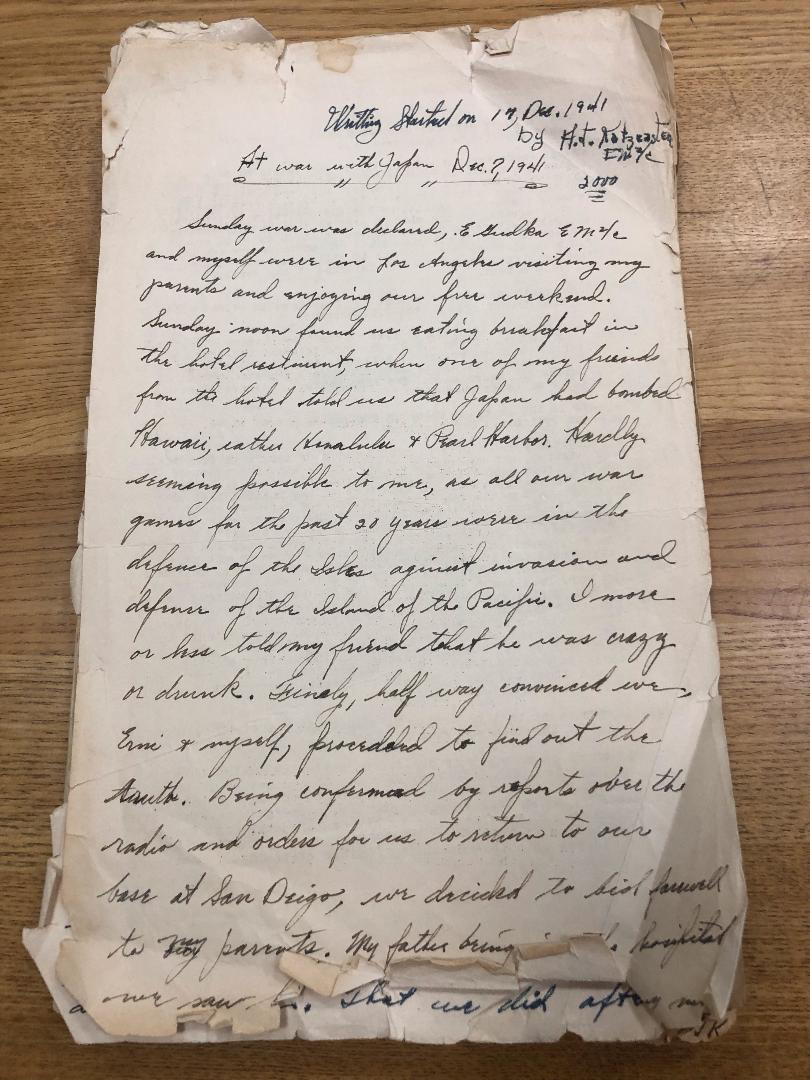A vivid account of searching the wreckage of ships sunk during the Pearl Harbor attack is now part of the archives at the Redwood City library’s history room. A rare diary kept by a Navy “hard hat“ salvage diver details what he saw during a dangerous job that started just 10 days after the Japanese attack that launched America into World War II. Included are graphic descriptions of remains found aboard the USS Arizona, whose hull is now a national memorial.
The six-page document, which ends on August 2, 1942, came into possession of the archives by sheer serendipity, according to Marian Wydo, president of the archives committee. It was discovered at the home of Mike and Julie Markwith, found “among their mother’s things after her passing,” said Wydo, who thanked the Markwith family for the donation. “If anyone would like to see the original manuscript, please feel free to come to the Local History Room and we will be happy to show it to you.” She added that the next edition of the Journal of Local History, which is published by the archives, will carry the entire diary.
—
This story appeared in the March edition of Climate Magazine.
—
“It is a bit of history that needs to be preserved,” Mike Markwith said about the papers found at the home of his mother, Marilyn, who passed away last April. He said the family didn’t know what to do with the diary until his wife, Julie, suggested it be in the archives. No one knows the name of the sailor who wrote the diary, which is in longhand. Time has erased much of the name at the top of the first page. It appears to be “A.J. Katz something,” followed by what seems to be his rating, an electrician’s mate.
Rare Find
“These types of accounts are particularly rare, as keeping a diary was forbidden due to security concerns during the war,” Scott Pawlowski, curator at the Pearl Harbor National Memorial, told Climate. “That sounds like an amazing diary.” Indeed it is, especially the author’s reporting of his dive to the Arizona, which remains a cemetery for hundreds of men killed in the attack. Of the 2,335 military fatalities in the attack 1,177 were aboard the Arizona.
“The sight is terrible,” the diver wrote. “To be quite frank, there are thousands of bones broken into bits, lying all over the deck. There also are shoes in various spots that the foot still remains.” The battleship was “the most sickening sight,” he continued. He also inspected the remains of the battleship West Virginia where “we ran into a body lying across the hatch which we had to open. We left it or rather I should say pushed it aside as any attempt to bring it up would have been foolish as it would have broken apart.” The unidentified diver recovered the commission pennant “that flew on the Arizona, the one she carried on the day she was sunk – Dec. 7, 1941.”
The diver’s diary is in rare company. When the book “Descent into Darkness” was published in 1996, it was billed as the only first-hand account of the salvage work at Pearl Harbor. The book by Navy Commander Edward Rayner, who passed away in 1997, tells how divers operated in waters so dark they couldn’t see much beyond the front of their helmets.
Hazardous Salvage Work
There was always the fear of unexploded ammunition going off. According to the book, the divers memorized the blueprints of each ship and then guided themselves by feeling their way through the wreckage. Eight battleships were damaged, with four sunk. All but the Arizona were salvaged.
Will the identity of the author of the diary ever surface? David Conlin, head of the National Park Service’s Submerged Resources Center, has sought the aid of historians and others in the quest to find out. Conlin said, however, that there is a good chance “your question cannot be known.”
Markwith has a theory. He said his father was a sailor who was sent to Pearl Harbor after the bombing. “I do recall his talking about some of his buddies who were divers. Maybe this was written by one of them. As for how he took possession of this diary, we will never know.”






